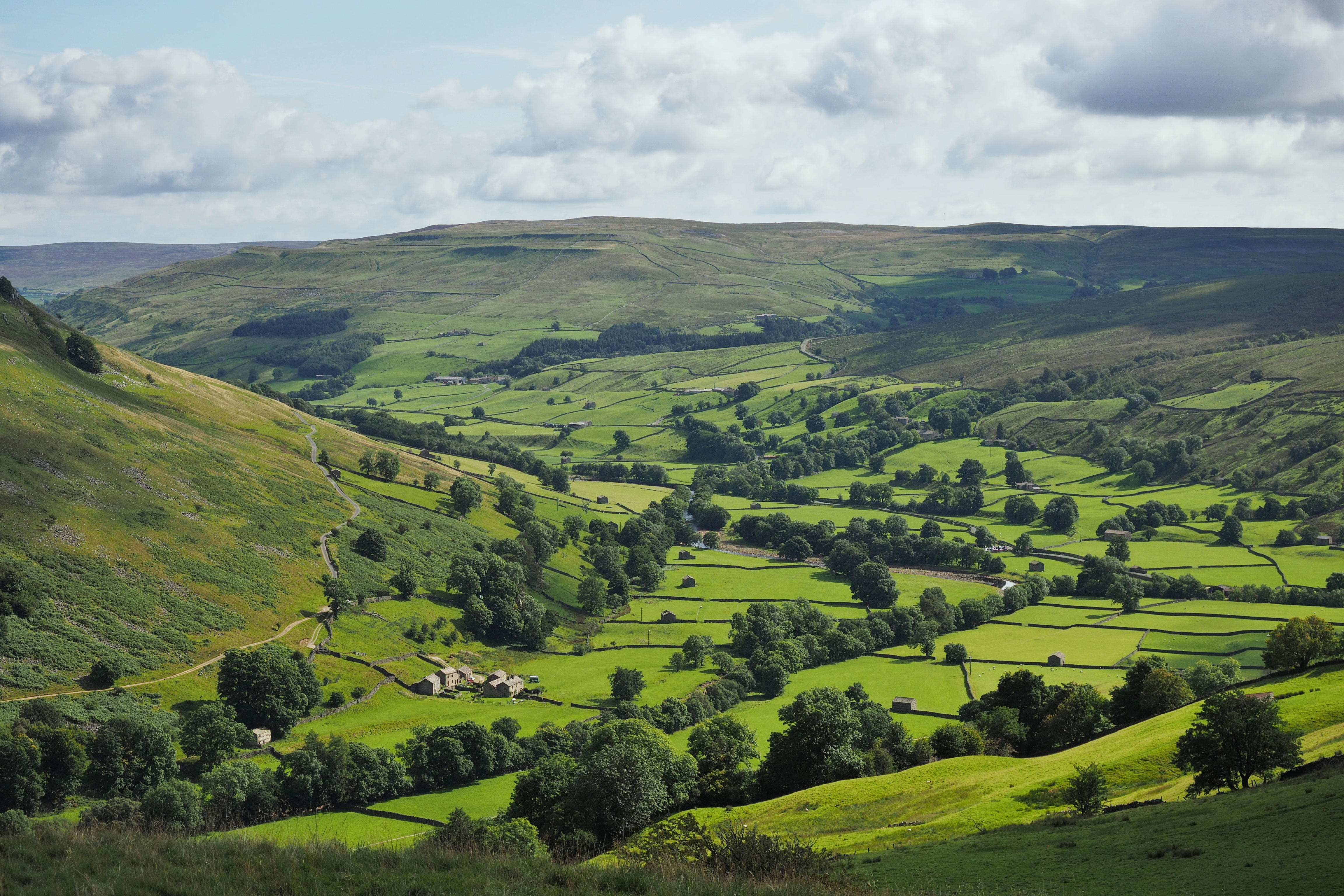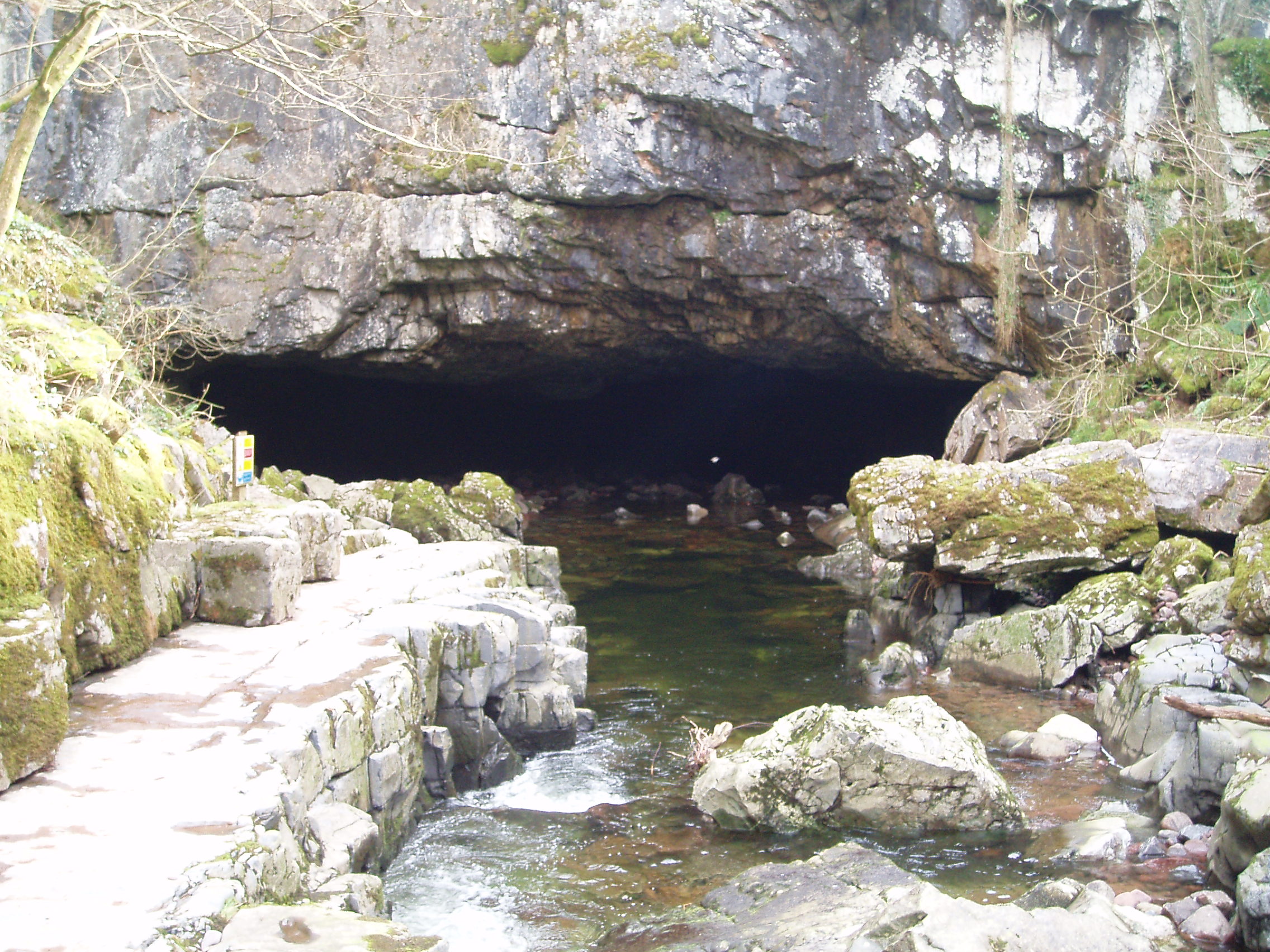|
Mossdale Caverns
Mossdale Caverns is a cave system in the Yorkshire Dales, England. It is about north of Grassington, and east of Conistone, where Mossdale Beck sinks at the base of Mossdale Scar. It lies at an altitude of on the eastern flank of Wharfedale, and extends south-east beneath Grassington Moor. The cave system is formed within the Middle Limestone of the Yoredale Series. The large stream (average flow 100 litres/second) has been shown by dye testing to resurge at Black Keld, some to the WNW lower. Speleology Eli Simpson, a founder of the British Speleological Association, had become convinced there was a large undiscovered caving system in the area and devoted much of his time to finding it. Simpson later enlisted the help of fellow B.S.A. member Bob Leakey, who recruited a team of female co-workers from Yeadon aircraft factory to help the exploration of Mossdale Scar. (The Second World War had created a local shortage of able bodied males) On 31 May 1941, while searching for a ... [...More Info...] [...Related Items...] OR: [Wikipedia] [Google] [Baidu] |
Cave Rescue
Cave rescue is a highly specialized field of wilderness rescue in which injured, trapped or lost cave explorers are medically treated and extracted from various cave environments. Cave rescue borrows elements from firefighting, confined space rescue, rope rescue and mountaineering techniques but has also developed its own special techniques and skills for performing work in conditions that are almost always difficult and demanding. Since cave accidents, on an absolute scale, are a very limited form of incident, and cave rescue is a very specialized skill, normal emergency staff are rarely employed in the underground elements of the rescue. Instead, this is usually undertaken by other experienced cavers who undergo regular training through their organizations and are called up at need. Cave rescues are slow, deliberate operations that require both a high level of organized teamwork and good communication. The extremes of the cave environment (air temperature, water, vertical depth) ... [...More Info...] [...Related Items...] OR: [Wikipedia] [Google] [Baidu] |
Yorkshire Dales
The Yorkshire Dales is an upland area of the Pennines in the Historic counties of England, historic county of Yorkshire, England, most of it in the Yorkshire Dales National Park created in 1954. The Dales comprise river valleys and the hills rising from the Vale of York westwards to the hilltops of the Pennine Drainage divide, watershed. In Ribblesdale, Dentdale and Garsdale, the area extends westwards across the watershed, but most of the valleys drain eastwards to the Vale of York, into the River Ouse, Yorkshire, Ouse and the Humber. The extensive limestone cave systems are a major area for caving in the UK and numerous walking trails run through the hills and dales. Etymology The word ''Dale (landform), dale'', like ''dell'', is derived from the Old English word ''dæl''. It has cognates in the North Germanic languages, Nordic/Germanic languages, Germanic words for valley (''dal'', ''tal''), and occurs in valley names across Yorkshire and Northern England. Usage here may have ... [...More Info...] [...Related Items...] OR: [Wikipedia] [Google] [Baidu] |
1967 In England
Events January * January 1 – Canada begins a year-long celebration of the 100th anniversary of Confederation, featuring the Expo 67 World's Fair. * January 5 ** Spain and Romania sign an agreement in Paris, establishing full consular and commercial relations (not diplomatic ones). ** Charlie Chaplin launches his last film, ''A Countess from Hong Kong'', in the UK. * January 6 – Vietnam War: USMC and ARVN troops launch '' Operation Deckhouse Five'' in the Mekong Delta. * January 8 – Vietnam War: Operation Cedar Falls starts. * January 13 – A military coup occurs in Togo under the leadership of Étienne Eyadema. * January 14 – The Human Be-In takes place in Golden Gate Park, San Francisco; the event sets the stage for the Summer of Love. * January 15 ** Louis Leakey announces the discovery of pre-human fossils in Kenya; he names the species '' Kenyapithecus africanus''. ** American football: The Green Bay Packers defeat the Kansas City Chiefs 35–10 in th ... [...More Info...] [...Related Items...] OR: [Wikipedia] [Google] [Baidu] |
1967 Disasters In The United Kingdom
Events January * January 1 – Canada begins a year-long celebration of the 100th anniversary of Confederation, featuring the Expo 67 World's Fair. * January 5 ** Spain and Romania sign an agreement in Paris, establishing full consular and commercial relations (not diplomatic ones). ** Charlie Chaplin launches his last film, ''A Countess from Hong Kong'', in the UK. * January 6 – Vietnam War: USMC and ARVN troops launch ''Operation Deckhouse Five'' in the Mekong Delta. * January 8 – Vietnam War: Operation Cedar Falls starts. * January 13 – A military coup occurs in Togo under the leadership of Étienne Eyadema. * January 14 – The Human Be-In takes place in Golden Gate Park, San Francisco; the event sets the stage for the Summer of Love. * January 15 ** Louis Leakey announces the discovery of pre-human fossils in Kenya; he names the species '' Kenyapithecus africanus''. ** American football: The Green Bay Packers defeat the Kansas City Chiefs 35–10 in the ... [...More Info...] [...Related Items...] OR: [Wikipedia] [Google] [Baidu] |
Wild Caves
Wild, wild, wilds or wild may refer to: Common meanings * Wildlife, Wild animal * Wilderness, a wild natural environment * Wildness, the quality of being wild or untamed Art, media and entertainment Film and television * Wild (2014 film), ''Wild'' (2014 film), a 2014 American film from the 2012 book * Wild (2016 film), ''Wild'' (2016 film), a 2016 German film * ''The Wild'', a 2006 Disney 3D animation film * Wild (TV series), ''Wild'' (TV series), a 2006 American documentary television series * The Wilds (TV series), a 2020 fictional television series Literature * ''Wild: From Lost to Found on the Pacific Crest Trail'' a 2012 non-fiction book by Cheryl Strayed * ''Wild, An elemental Journey'', a 2006 autobiographical book by Jay Griffiths * The Wild (novel), ''The Wild'' (novel), a 1991 novel by Whitley Strieber * ''The Wild'', a science fiction novel by David Zindell * ''The Wilds'', a 1998 limited-edition horror novel by Richard Laymon Music * Wild (band), ''Wild'' (band), a ... [...More Info...] [...Related Items...] OR: [Wikipedia] [Google] [Baidu] |
Limestone Caves
Limestone ( calcium carbonate ) is a type of carbonate sedimentary rock which is the main source of the material lime. It is composed mostly of the minerals calcite and aragonite, which are different crystal forms of . Limestone forms when these minerals precipitate out of water containing dissolved calcium. This can take place through both biological and nonbiological processes, though biological processes, such as the accumulation of corals and shells in the sea, have likely been more important for the last 540 million years. Limestone often contains fossils which provide scientists with information on ancient environments and on the evolution of life. About 20% to 25% of sedimentary rock is carbonate rock, and most of this is limestone. The remaining carbonate rock is mostly dolomite, a closely related rock, which contains a high percentage of the mineral dolomite, . ''Magnesian limestone'' is an obsolete and poorly-defined term used variously for dolomite, for limestone co ... [...More Info...] [...Related Items...] OR: [Wikipedia] [Google] [Baidu] |
British Cave Research Association
The British Cave Research Association (BCRA) is a speleological organisation in the United Kingdom. Its object is to promote the study of caves and associated phenomena, and it attains this by supporting cave and karst research, encouraging original exploration (both in the UK and on expeditions overseas), collecting and publishing speleological information, maintaining a library and organising educational and scientific conferences and meetings. BCRA is a registered charity in the UK, and a constituent body of the British Caving Association (BCA), undertaking charitable activities on behalf of BCA. History The British Cave Research Association arose from a merger in 1973 of the British Speleological Association (BSA) and the Cave Research Group of Great Britain (CRG). When the National Caving Association (NCA) was formed in 1968, BCRA became one of its constituent bodies. Although NCA was recognised as the governing body for UK caving by the Sports Council it did not allow in ... [...More Info...] [...Related Items...] OR: [Wikipedia] [Google] [Baidu] |
Cairn
A cairn is a man-made pile (or stack) of stones raised for a purpose, usually as a marker or as a burial mound. The word ''cairn'' comes from the gd, càrn (plural ). Cairns have been and are used for a broad variety of purposes. In prehistoric times, they were raised as markers, as memorials and as burial monuments (some of which contained chambers). In modern times, cairns are often raised as landmarks, especially to mark the summits of mountains. Cairns are also used as trail markers. They vary in size from small stone markers to entire artificial hills, and in complexity from loose conical rock piles to elaborate megalithic structures. Cairns may be painted or otherwise decorated, whether for increased visibility or for religious reasons. A variant is the inuksuk (plural inuksuit), used by the Inuit and other peoples of the Arctic region of North America. History Europe The building of cairns for various purposes goes back into prehistory in Eurasia, ranging in s ... [...More Info...] [...Related Items...] OR: [Wikipedia] [Google] [Baidu] |
List Of UK Caving Fatalities
This is a list of recreational caving fatalities in the United Kingdom. It includes all verified deaths associated with the exploration of natural caves and disused mines in the modern era (post 1880). Deaths involving members of the general public who may have slipped down a shaft, or wandered into a cave without being aware of the risks, have been excluded. Caving cannot be considered a particularly dangerous pastime. In 2018, there were up to 4,000 regular cavers in the UK, and about 70,000 people who went on instructor-led courses into caves in the Yorkshire Dales, but there were no fatalities. List of fatalities The following is a list of the 136 identified recorded fatalities associated with recreational caving in the UK. The main causes of death have been drowning when cave diving, drowning as the result of flooding or negotiating deep water, injuries incurred from falling from a height, and injuries incurred as the result of rock falls. In ten cases the bodies have no ... [...More Info...] [...Related Items...] OR: [Wikipedia] [Google] [Baidu] |
Coroner
A coroner is a government or judicial official who is empowered to conduct or order an inquest into Manner of death, the manner or cause of death, and to investigate or confirm the identity of an unknown person who has been found dead within the coroner's jurisdiction. In medieval times, English coroners were Crown officials who held financial powers and conducted some judicial investigations in order to counterbalance the power of sheriffs or bailiffs. Depending on the jurisdiction, the coroner may adjudge the cause of death personally, or may act as the presiding officer of a special court (a "coroner's jury"). The term ''coroner'' derives from the same source as the word ''Crown (headgear), crown''. Duties and functions Responsibilities of the coroner may include overseeing the investigation and certification of deaths related to mass disasters that occur within the coroner's jurisdiction. A coroner's office typically maintains death records of those who have died within th ... [...More Info...] [...Related Items...] OR: [Wikipedia] [Google] [Baidu] |
In Situ
''In situ'' (; often not italicized in English) is a Latin phrase that translates literally to "on site" or "in position." It can mean "locally", "on site", "on the premises", or "in place" to describe where an event takes place and is used in many different contexts. For example, in fields such as physics, geology, chemistry, or biology, ''in situ'' may describe the way a measurement is taken, that is, in the same place the phenomenon is occurring without isolating it from other systems or altering the original conditions of the test. The opposite of ''in situ'' is ''ex situ''. Aerospace In the aerospace industry, equipment on-board aircraft must be tested ''in situ'', or in place, to confirm everything functions properly as a system. Individually, each piece may work but interference from nearby equipment may create unanticipated problems. Special test equipment is available for this ''in situ'' testing. It can also refer to repairs made to the aircraft structure or flight con ... [...More Info...] [...Related Items...] OR: [Wikipedia] [Google] [Baidu] |






